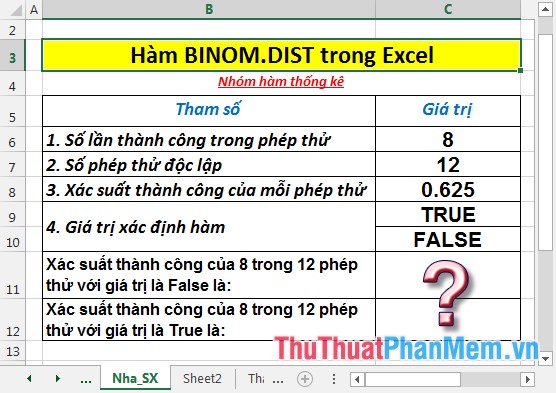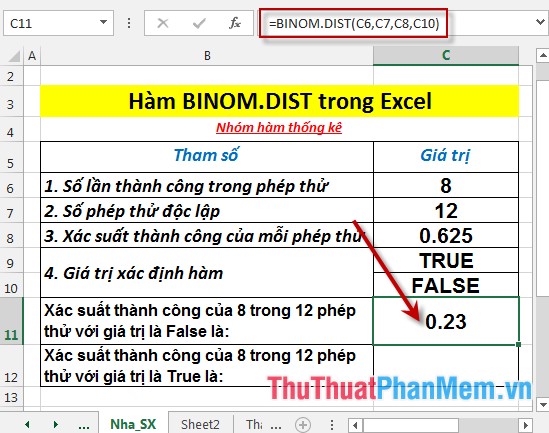BINOM.DIST function - Function returns the probability of binomial distribution of individual terms in Excel
The following article introduces you to the BINOM.DIST function - one of the functions in the statistical function group is very popular in Excel.

Description: The function returns the binomial distribution probability of the individual term. Support function from Excel 2010 version.
Syntax: BINOM.DIST (number_s, trials, probability_s, cumulative)
Inside:
- number_s: number of successes in the test, a required parameter.
- trials: Number of independent trials, required.
- probability_s: The probability of success of each test, is a required parameter.
- cumulative: Logical value determines the form of the function if it is True -> returns the cumulative distribution function, if the False value returns the probability mass function .
Attention:
- If number_ s and trials are not whole numbers they are truncated to whole numbers.
- If number_ s and trials are not numbers -> the function returns the #VALUE! Error value
- If number_s <0 or number_s > trials -> the function returns the #NUM! Error value
- If probability_s <0 or probability_s> 1 -> the function returns the #NUM! Error value
- Binomial probability function is:
[bleft ({x, n, p} right) = left ({begin {array} {* {20} {c}}
n
x
end {array}} right) {p ^ N} {left ({1 - p } right) ^ {n - N}}]
Inside:
(left ({begin {array} {* {20} {c}} nx end {array}} right)): COMBIN (n, x).
- Cumulative binomial distribution function is:
[Bleft ({x, n, p} right) = sumlimits_ {y = 0} ^ N {bleft ({y, n, p} right)}]
For example:
Calculate the probabilities of the tests with the data in the table below:

- Calculate the probability of success in 8 of the 12 tests with a value of False. In the cell to calculate enter the formula : = BINOM.DIST (C6, C7, C8, C10)

- Press Enter -> probability of success is:

- Calculate the probability of success in 8 of the 12 tests with a value of True. In the cell to calculate enter the formula : = BINOM.DIST (C6, C7, C8, C9)

- Press Enter -> probability of success is:

So with different function defined values -> the function returns the same result.
Above are instructions and specific examples when using the BINOM.DIST function in Excel.
Good luck!
You should read it
- F.DIST - The function returns the probability distribution F in Excel
- BINOM.INV function - The function returns the smallest value with cumulative binomial distribution greater or equal to the standard value in Excel
- F.DIST.RT function - The function returns the right probability distribution F for 2 data sets in Excel
- CHISQ.DIST.RT function - The function returns the right end probability of the distribution when squared in Excel
- POISSON.DIST function - The function returns the Poisson distribution in Excel
- GAMMA.DIST function - The function returns the gamma distribution in Excel
 BINOM.DIST.RANGE function - The function returns the probability of a test result using binomial distribution in Excel
BINOM.DIST.RANGE function - The function returns the probability of a test result using binomial distribution in Excel BINOM.INV function - The function returns the smallest value with cumulative binomial distribution greater or equal to the standard value in Excel
BINOM.INV function - The function returns the smallest value with cumulative binomial distribution greater or equal to the standard value in Excel CHISQ.DIST - Function returns the distribution when squared in Excel
CHISQ.DIST - Function returns the distribution when squared in Excel CHISQ.DIST.RT function - The function returns the right end probability of the distribution when squared in Excel
CHISQ.DIST.RT function - The function returns the right end probability of the distribution when squared in Excel CHISQ.INV function - The function returns the inverse of the probability of the left end of the distribution when squared in Excel
CHISQ.INV function - The function returns the inverse of the probability of the left end of the distribution when squared in Excel CHISQ.INV.RT function - The function returns the inverse of the right end probability of the distribution when squared in Excel
CHISQ.INV.RT function - The function returns the inverse of the right end probability of the distribution when squared in Excel